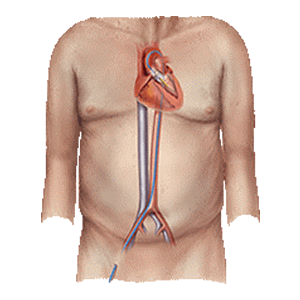TAVR Procedure
TAVR is different from open-heart surgery in that it is a less invasive approach to treat your diseased valve. The TAVR team will determine the best approach for replacing your valve once your entire evaluation is completed. The information below will give you an idea of the procedures we use to do the initial prospective patient evaluation and then how we approach the actual surgery.
TAVR Procedure: Step-by Step Patient Evaluation
Aortic stenosis is a complex diagnosis that requires the Heart Team to perform a comprehensive exam and obtain pertinent tests in order to get a complete understanding of how this disease process has impacted your quality of life and overall health.
A typical outline of the evaluation process to confirm whether you are a candidate for TAVR includes the following steps:
- Echocardiogram
This ultrasound of the heart is usually the first study done to diagnose aortic stenosis. - Cardiac Catheterization (Angiogram)
Cardiac catheterization, or angiogram, allows cardiologists to evaluate the arteries of your heart, assess pressures within the heart chambers, and measure the severity of the aortic valve stenosis. - CAT Scan with Angiography (or CTA)
A CTA is a type of X-ray performed in the radiology department. Scans of your heart and chest/abdomen/pelvis will help in determining what size valve you will need and how the Heart Team will enter the body to deliver the new valve. Because this test uses contrast dye, it may be necessary for you to come to the hospital for a few hours to receive IV fluids to protect your kidneys. If you have kidney insufficiency, these two scans may be divided into separate days. - Cardiac Surgery Consultation
Currently, TAVR is only approved for patients who met a certain risk criteria. In order to qualify for TAVR, you must be deemed at least intermediate risk. Our cardiothoracic surgeon will evaluate your overall individual risk to successfully undergo open aortic valve replacement. - Additional Testing/Consults
Occasionally the heart team will determine that it is necessary to obtain additional testing or have you be seen by other physicians based on your symptoms and medical history. - Heart Team Review
Once you have completed all components of evaluation, your case will be discussed at our weekly collaborative valve conference meeting. At this meeting, the team will review all diagnostic data and confirm a treatment plan that is best suited for your needs. This plan will be communicated back to you and your loved ones for discussion so you can make a decision about how you would like to proceed.
TAVR Procedure: TAVR Approach Selection
TAVR can be done in multiple ways, but the most common approach involves a small incision made in the leg. This is called the transfemoral approach. Other approaches for TAVR may be considered by your doctor depending on your specific anatomy, which is determined by your CT scan. These alternative approaches include making a small incision in the neck (carotid), small incision under the collarbone (subclavian), an incision in the right upper chest (aortic), an incision in your left lower chest (apical), or small incision in the leg into a large vein transferred to an artery (transcaval).
Depending on your health and the procedural approach recommended by your doctor, the average time of the procedure is two to three hours.
Depending on your health care needs, the team will determine what type of anesthesia is best for you. You will likely be awake and given medication to help you relax and block pain. Sometimes, it may be necessary to be fully asleep.
As with any medical procedure, there are risks. Although this is a lower risk procedure, it does not mean there is no risk. The risks of TAVR include: needing a permanent pacemaker, bleeding, vascular complications, stroke, kidney failure and even death.
Step-by-Step Transfemoral Approach
 A small incision is made in your upper leg. If we are unable to go through the leg, your team will discuss one of the alternative approaches mentioned above. Your doctor will insert a short, hollow tube called a sheath into your femoral artery. The new valve is compressed and then placed on a delivery system (a small tube).
A small incision is made in your upper leg. If we are unable to go through the leg, your team will discuss one of the alternative approaches mentioned above. Your doctor will insert a short, hollow tube called a sheath into your femoral artery. The new valve is compressed and then placed on a delivery system (a small tube).
The delivery system carrying the valve is advanced to your heart across your aortic valve. Once it reaches your diseased valve, your old valve is pushed aside and the new valve remains in place. An ultrasound of your heart is done after your new valve is replaced to ensure it is functioning properly before removing the delivery system and closing the incision in your leg.
Typically patients stay in the hospital one to two days after their TAVR. If an alternative approach is used other than the leg, your hospital stay may be longer.
More TAVR Procedure Information:
TAVR Recovery: Life After TAVR
Learn more about Transcatheter Aortic Valve Replacement in this section of the website or call 760-837-8385 to make an appointment with a member of the Heart Valve Team to discuss whether TAVR is a fit for your situation and how Eisenhower’s award-winning TAVR team approaches aortic valve replacement.




